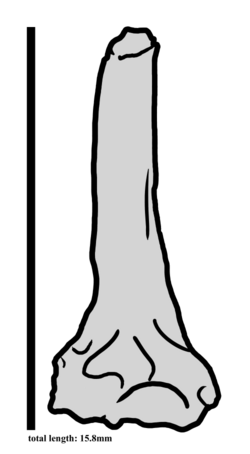Biology:Yatenavis
| Yatenavis | |
|---|---|

| |
| Holotype humerus of Yatenavis | |
| Scientific classification | |
| Domain: | Eukaryota |
| Kingdom: | Animalia |
| Phylum: | Chordata |
| Clade: | Dinosauria |
| Clade: | Saurischia |
| Clade: | Theropoda |
| Clade: | Avialae |
| Clade: | †Enantiornithes |
| Genus: | †Yatenavis Herrera et al., 2022 |
| Species: | †Y. ieujensis
|
| Binomial name | |
| †Yatenavis ieujensis Herrera et al., 2022
| |
Yatenavis (meaning "stone bird") is an extinct genus of enantiornithine bird from the Late Cretaceous Chorrillo Formation of Santa Cruz Province, Argentina . The genus contains a single species, Y. ieujensis, known from a partial humerus.[1]
Discovery and naming
The Yatenavis holotype specimen, MPM-PV-23086, was discovered in sediments of the Chorrillo Formation near Estancia La Anita, Calafate, Santa Cruz Province, Argentina . This specimen consists of the distal right humerus.[1]
In 2022, Herrera et al. described Yatenavis ieujensis, a new genus and species of enantiornithine, based on these fossil remains. The generic name, "Yatenavis", combines the Aonikenk word for "stone" with the Latin word "avis", meaning "bird". The specific name, "ieujensis", is derived from "ieuj", the Aonikenk word for "snow". Yatenavis represents the eighth enantiornithine named from South America.[1]
Description
Herrera et al. (2022) concluded that Yatenavis would have had a body size comparable to extant sparrows. The fossil material bears similar features to Late Cretaceous enantiornithines from various locations across the world, including Madagascar , North America, Patagonia, and Central Asia.[1]
Paleoecology
Yatenavis represents the southernmost record of enantiornithines. As enantiornithines are uncommon in high-latitude and cold environments (which were more frequently inhabited by ornithurines), the discovery of Yatenavis in the Chorrillo Formation is surprising. Yatenavis coexisted with the ornithurine Kookne and a large indeterminate enantiornithine.[1] Non-avian dinosaurs, including the elasmarian ornithopod Isasicursor, the titanosaurian Nullotitan, and the megaraptorid Maip, have also been named from the Chorrillo Formation.[2][3]
References
- ↑ Novas, Fernando; Agnolin, Federico; Rozadilla, Sebastián; Aranciaga-Rolando, Alexis; Brissón-Eli, Federico; Motta, Matias; Cerroni, Mauricio; Ezcurra, Martín et al. (2019). "Paleontological discoveries in the Chorrillo Formation (upper Campanian-lower Maastrichtian, Upper Cretaceous), Santa Cruz Province, Patagonia, Argentina". Revista del Museo Argentino de Ciencias Naturales. Nueva Serie 21 (2): 217–293. doi:10.22179/revmacn.21.655. ISSN 1853-0400. https://www.researchgate.net/publication/337901475.
- ↑ Rolando, Alexis M. A.; Motta, Matias J.; Agnolín, Federico L.; Manabe, Makoto; Tsuihiji, Takanobu; Novas, Fernando E. (2022-04-26). "A large Megaraptoridae (Theropoda: Coelurosauria) from Upper Cretaceous (Maastrichtian) of Patagonia, Argentina". Scientific Reports 12 (1): Article number 6318. doi:10.1038/s41598-022-09272-z. PMID 35474310. Bibcode: 2022NatSR..12.6318A.
Wikidata ☰ Q115725375 entry
 |


